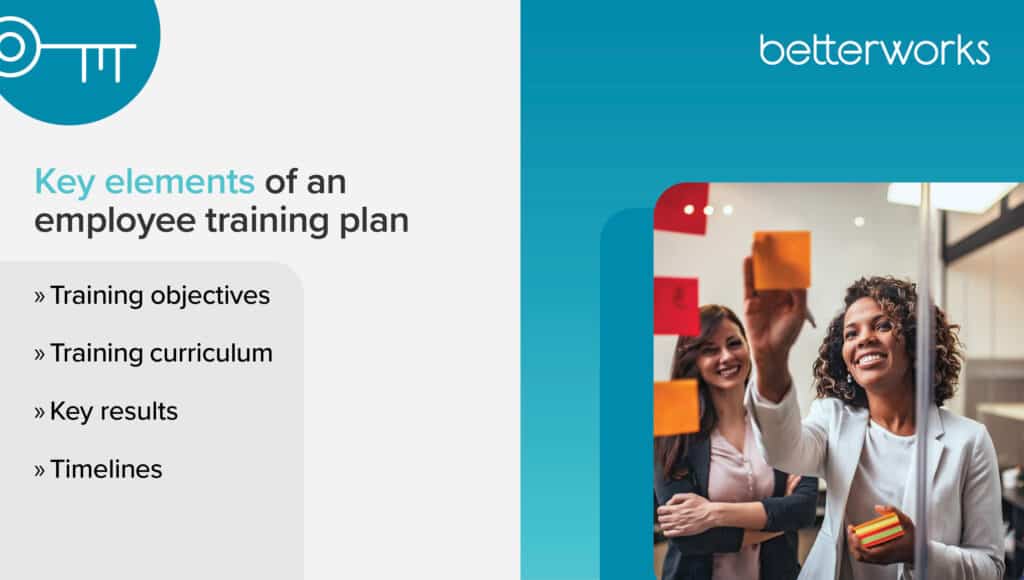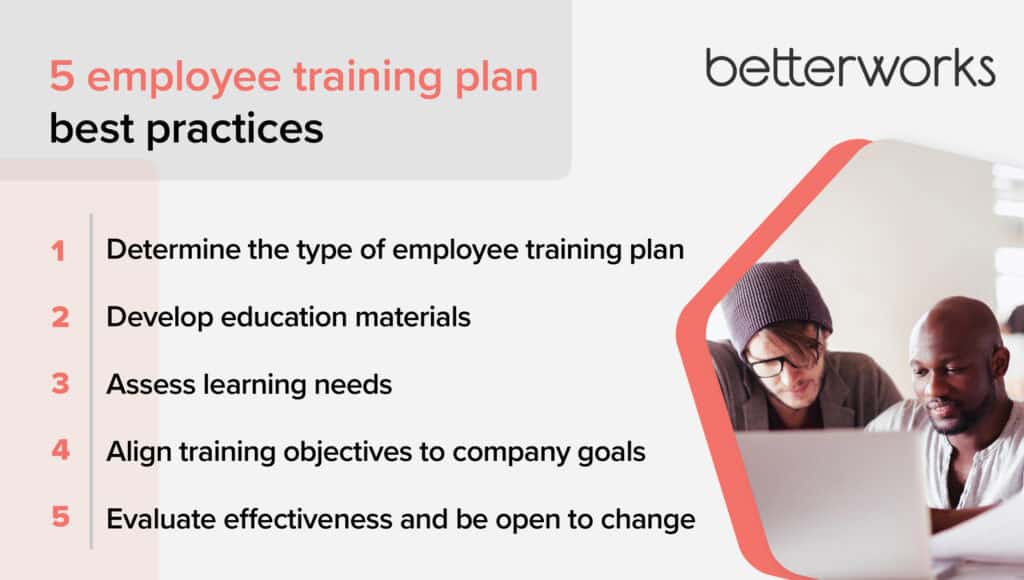As your industry changes, so do the skills your workforce needs to remain competitive. Your team members need consistent, targeted training to keep their skills sharp. An employee training plan and template can help.
Managers want help in making their teams better. Thirty-nine percent of managers who participated in the Betterworks 2022 State of Performance Enablement Report said tools for upskilling their team members would help them improve performance. Employee training plans can help them operationalize those efforts at scale.
Learn more about what goes into successful training plans and how you can create one for your organization’s unique needs.
What is an employee training plan?
Employee training plans are documents that codify your training program. They outline the goals of the training, intended learning outcomes, curricula, and training methods.
Individual training plans can have varying levels of detail beneath these high-level categories, including schedules, checklists, prerequisites, milestones, and learning outcomes.
Why do you need employee training plans?
Employee training plans allow you to standardize and better structure your organization’s employee development efforts, which benefits the business in a variety of ways.
Increase employee engagement
Employee training plans can help you build a learning culture. As people learn new skills and competencies, they build confidence and the ability to generate greater impact. This translates into better performance, increased engagement, and higher retention rates.
Employees want the opportunity to learn, and the benefits of training go beyond the sessions themselves. According to the 2021 Gallup-Amazon Upskilling Report, 71% of workers who participated in upskilling programs reported greater job satisfaction. Leveraging modern tools like learning experience platforms can enhance these training opportunities, offering personalized and interactive learning experiences.
Close workforce skills gaps
Employee training plans can help you implement a structured approach to filling workforce knowledge gaps through intentional upskilling programs or creating an employee cross-training plan template.
Control bias through consistency
When employee training plans are ad hoc, unfair bias can creep in. Standardized employee training plans create and enforce more objective reasoning behind which employees have access to different learning opportunities.
3 common types of employee training plans
Employee training plans can vary depending on your industry and job type, but they often fall into three general categories.
New hire training plans
A successful new-hire training plan supports new team members in their first days on the job and sets them up for success. These plans are used in conjunction with onboarding processes.
Onboarding and new hire training plans have similar concepts but different objectives. Onboarding ensures the new hire has the resources needed to do the job while acclimating them to the company’s culture. New hire training plans focus on equipping the employee with the skills necessary to complete the job’s tasks and goals. A new hire training plan will include goal-setting with the direct supervisor, skill-building, and long-term development.
These plans likely have customized components based on the job role. A new sales hire, and a new accountant might overlap in their training, but they’ll also have tasks specific to the work they’ll be doing. If the company requires all new hires to take ethics training, they will take that course in addition to their specialized training.
Employee development plans
Employee development plans are proactive, focusing on acquiring new skills and competencies based on people’s career goals. These plans can be short- or long-term, but they ideally prepare employees for their next role, whether that’s a promotion or a lateral move.
Employee development plans align with company goals and can be customized extensively based on each employee’s job role, career status, and unique needs. For example, an individual contributor who wants to move into management might collaborate with their supervisor on an employee development plan that spells out what they need to learn to take on this responsibility.
Safety training plans
Safety training can be organization-wide — such as mandatory cybersecurity or slip-and-fall training in an industrial setting. It might even be a regulated requirement in your industry. Safety training ensures employees understand and follow safety protocols for a variety of situations, such as fires or workplace accidents. These plans might also cover how to document hazards and report incidents.
Safety training plans can be customized based on the needs of your company. For example, healthcare organizations might have a module on workplace violence de-escalation training, while oil refineries might focus on containing spills.
4 key elements of an employee training plan
Each employee training plan’s structure will be unique but generally include four key elements.
Training objectives:
Your training plan’s high-level objectives should provide everyone with the same understanding of the training program’s goals. Training objectives should answer questions such as:
- What is the purpose of this initiative for the trainee and the company?
- What short- and long-term outcomes can employees expect to achieve after completing this training program?
Align the training’s objectives with your company’s business objectives. Make sure to communicate the training’s tangible benefits for employees. While the objectives should be concise, you can provide additional information to expand upon the high-level goals.
Training curriculum
Your training curriculum should consider such factors as the learning setting (e.g., classroom, virtual), training objectives, cost, timeline, class size, and whether any training elements must meet regulatory guidelines.
For example, a healthcare organization that wants to pursue workplace violence de-escalation AI certification dumps would need to commit to in-person training to meet all course requirements. However, an insurance company that wants its sales team leaders to get better at social media could sign them up for online training.
Metrics for success
How do you know your training is effective?
Defining those key results depends on how your organization identifies and measures success. Detail what metrics you plan to measure, how often you’ll measure them, and how these objectives and key results align with other organizational goals.
Timelines
Be clear about when training will take place or, if self-directed, the deadline for completion. For self-directed training, include estimates of how long the work should take. Note whether this training will occur during the workday — and, if it’s outside their regular hours, whether employees be paid for it.
Your timelines could be clarified by checklists, schedules, manager check-ins, or milestones.

5 employee training plan best practices
While training plans will need to be customized to your organization, there are some established best practices to keep in mind.
Determine the type of employee training plan
Sometimes, the choice is easy. Safety training plans have clear, specific purposes, and you might be required to hold such training. But even in these situations, you might need to make nuanced choices, such as selecting among multiple vendors with different presentation styles.
Consider factors such as your overall training objectives, the setting of the training, the planned curriculum, your timeline, and your budget. These factors can narrow down which training plans are best for your organization.
The training you’ve done in the past can offer guidance, too. Repurposing existing plans can save you time and add consistency. However, you might find that old training no longer serves your needs, and you need a new approach.
Develop education materials
Education materials can be any type of information that facilitates learning within a training environment. These materials include digital documents, quizzes, training manuals, presentations, videos, and assessments. To make resources more accessible and interactive, use QR Code Generators. This allows learners to quickly scan and access digital content through their mobile devices.
Organizations can develop in-house materials or turn to vendors, depending on their needs and resources. Others create the training concepts but outsource the content creation process.
The first step is to audit your existing training materials for accuracy, past performance, and potential for improvement. For example, handouts for a training course may need to be updated with new information.
Employees may have different learning styles, so determine a training delivery method based on your industry and workforce. The method may vary depending on the course objectives or skills being taught.
Create a framework outlining the material to be covered in training. This process is detailed, requiring each concept to be broken down like a lesson plan.
Assess learning needs
Start by finding out what your employees already know. You can perform a pre-training needs assessment to identify knowledge strengths and gaps. Based on those findings, you can build the business case for what training is needed and which training methods would be most effective.
Having assessment data to support your training plans can help earn leadership buy-in.
Align training objectives with company goals
Where does your organization want to be in the next two years? Five years? A decade?
Employee training is most beneficial when aligned with business goals. What does success look like for your organization, and what skills are needed to support those goals? Identify the existing skills gaps and the skills your organization will need in the future that your current workforce lacks.
Evaluate effectiveness and be open to change
Solicit anonymous feedback from employees on each part of your training initiative, so they feel comfortable speaking up without fear of retaliation. Even successful training initiatives will have flaws that can be improved on.
Stay open to change. Remember that you and your employees have the same goal — to make work better for everyone. If you made mistakes during this training initiative, evaluate what went wrong, and make improvements for next time.

Employee training plan templates
An employee training plan template should make clear to trainers, managers, and employees what the objectives are, what will occur during training, and how progress will be measured.
Below is an employee training template you can use as an example. We’ve broken down this template into sections so you can see how each element contributes to a comprehensive training document.
Basic employee information
Employee name:
Title:
Date:
Plan time frame:
Goals
Goals and metrics make the purpose of the training and how success will be measured clear for both the trainee and the company.
For example, an employee new to search engine optimization may have a short-term goal of taking an online SEO overview course. A long-term goal for that employee might be learning to create SEO content and use the online marketing tools to conduct keyword research.
Desired skills and competencies
This section clarifies the specific skill or competency the trainee will gain or strengthen by completing the proposed training. A short-term skill objective might be to learn how to perform a task, whereas a long-term goal might be to be able to teach the next wave of employees about that task.
Delivery method
This section specifies how the training will be conducted. For example, will it be an in-person course, a one-time webinar, or an online course? Include any vendor information, such as the institution providing the training.
Resources
What resources are necessary to secure the training for this employee? Include budget, number of hours, staffing requirements, and so forth.
Action plan
Break down your training curriculum into clear, actionable steps, each with a proposed start and finish. Besides listing tasks, note whether some tasks will need to be repeated or whether they could change based on the preceding steps.
Create your employee training plan roadmap
Employee training plans help you create a transparent roadmap of how you’re helping your workforce acquire the skills and competencies they need to do their jobs and elevate the organization’s performance.
Creating an employee training plan template takes time, requires input from stakeholders, and should be updated regularly. All that work pays off because targeted training is more effective and can improve employee engagement, productivity, and retention. When you have standardized training plans, you know what your employees are learning, and they know what they need to do to become more successful.
Discover 10 common mistakes made during employee onboarding.






